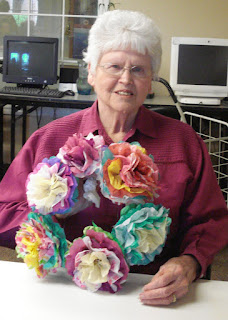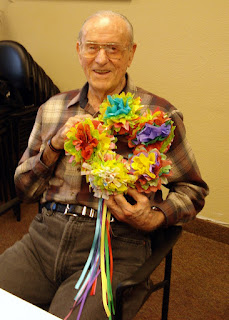With a slow-to-rebound economy and tight Activities budgets, one of the biggest challenges for Activities Directors who work with Seniors in Memory Care or Assisted Living Residences is deciding how to allocate their limited monthly Activities budget.
Why should they choose an art program over other entertainment? What are the benefits of choosing to incorporate creative art activities rather than opting for passive entertainment- even though the group participating in the art class may be smaller than a group enjoying a musical entertainer?
At first glance an entertainer seems to get more "bang for the buck". But participation in art programs has been shown to have a very positive long-term effect for residents. One compelling reason to incorporate an ongoing art program for residents is that while Alzheimer's and dementia damage the portions of the brain that have to do with memory and planning complex tasks, the part of the brain that is involved in emotion and aesthetic appreciation remains intact for much longer. Patients with Alzheimer's have difficulty with attention and concentration, but experts say that art therapy has provided an extraordinary outlet for them.
Dr. Gene Cohen, director of the Center on Aging at George Washington University, has studied the effect of art on people with Alzheimer's and has said "Art is a wonderful activity that taps into imagination. Even with the loss of memory, the capacity for imagination still has its place. That is one reason there has been increasing attention to art for people with Alzheimer's. Even as memory fades the imagination has the capacity to be robust.''
Art therapist Ruth Abraham, author of When Words Have Lost Their Meaning: Alzheimer's Patients Communicate Through Art (Praeger Publishers, 2004), agrees: "Art therapy has been shown to be a powerful tool for people with Alzheimer's; it helps them to express their feelings when they can no longer do so with words. This use of art helps people with Alzheimer's disease feel less lonely and isolated. It can also calm their restlessness."
Some of the proven benefits of engaging in creative activities with older adults are:
Why should they choose an art program over other entertainment? What are the benefits of choosing to incorporate creative art activities rather than opting for passive entertainment- even though the group participating in the art class may be smaller than a group enjoying a musical entertainer?
At first glance an entertainer seems to get more "bang for the buck". But participation in art programs has been shown to have a very positive long-term effect for residents. One compelling reason to incorporate an ongoing art program for residents is that while Alzheimer's and dementia damage the portions of the brain that have to do with memory and planning complex tasks, the part of the brain that is involved in emotion and aesthetic appreciation remains intact for much longer. Patients with Alzheimer's have difficulty with attention and concentration, but experts say that art therapy has provided an extraordinary outlet for them.
Dr. Gene Cohen, director of the Center on Aging at George Washington University, has studied the effect of art on people with Alzheimer's and has said "Art is a wonderful activity that taps into imagination. Even with the loss of memory, the capacity for imagination still has its place. That is one reason there has been increasing attention to art for people with Alzheimer's. Even as memory fades the imagination has the capacity to be robust.''
Art therapist Ruth Abraham, author of When Words Have Lost Their Meaning: Alzheimer's Patients Communicate Through Art (Praeger Publishers, 2004), agrees: "Art therapy has been shown to be a powerful tool for people with Alzheimer's; it helps them to express their feelings when they can no longer do so with words. This use of art helps people with Alzheimer's disease feel less lonely and isolated. It can also calm their restlessness."
Some of the proven benefits of engaging in creative activities with older adults are:
- Provides a form of nonverbal communication and expression
- Gives the individual a sense of choice and control
- Helps to reduce stress, fear, and anxiety
- Enriches relationships and encourages socialization
- Activates the senses and inspires spontaneity
- Encourages playfulness and a sense of humor
- Restores and motivates muscle memory
- Improves cognition and focuses attention
- Evokes new opportunities for connecting with others
- Reduces boredom
- Leads to self-expression and self-discovery
- Improves emotional and physical health
- Nurtures a sense of Self and renewed self-esteem
- Promotes relaxation and decreases disruptive behavior
I have seen first-hand while teaching art and craft classes to Seniors living in Memory Care and Assisted Living that they really do express their personal style, likes and dislikes, and individuality in their art projects although when some have later stage Alzheimer's. Even though we start each project with a sample to copy, similar color choices and supplies when individuals are encouraged to create their project in their own way- every project turns out unique and different- just like the person that created it.
Since I am not an art therapist, I don't have particular goals set for each class member when we are doing a project- we just concentrate on having fun, expressing creativity and socializing with the group. Many times class members are afraid they will "get it wrong" but with assurance that "There is no wrong or right in art" so they can't do anything wrong they feel freer to express themselves as they want. Going into a project with that attitude usually helps students relax and just enjoy the process- and the results can be truly amazing!
Doing something creative each day- whether it is gardening, listening to music, painting, cooking or telling stories- is a wonderful way for individuals coping with the effects of Alzheimer's and dementia to connect to an important part of who they are- and who they have always been.
Doing something creative each day- whether it is gardening, listening to music, painting, cooking or telling stories- is a wonderful way for individuals coping with the effects of Alzheimer's and dementia to connect to an important part of who they are- and who they have always been.










